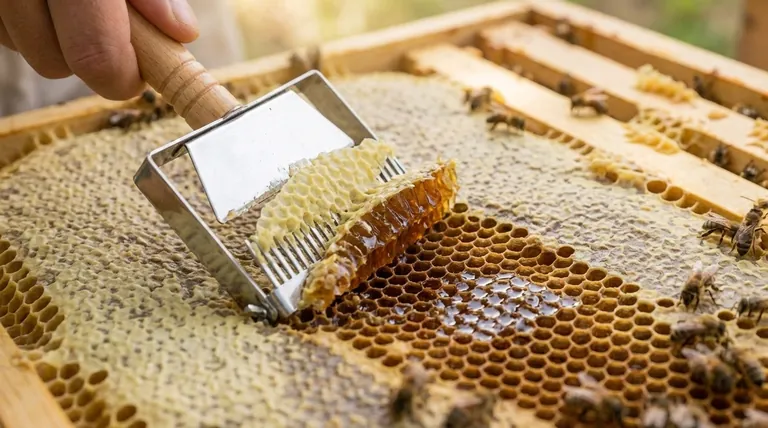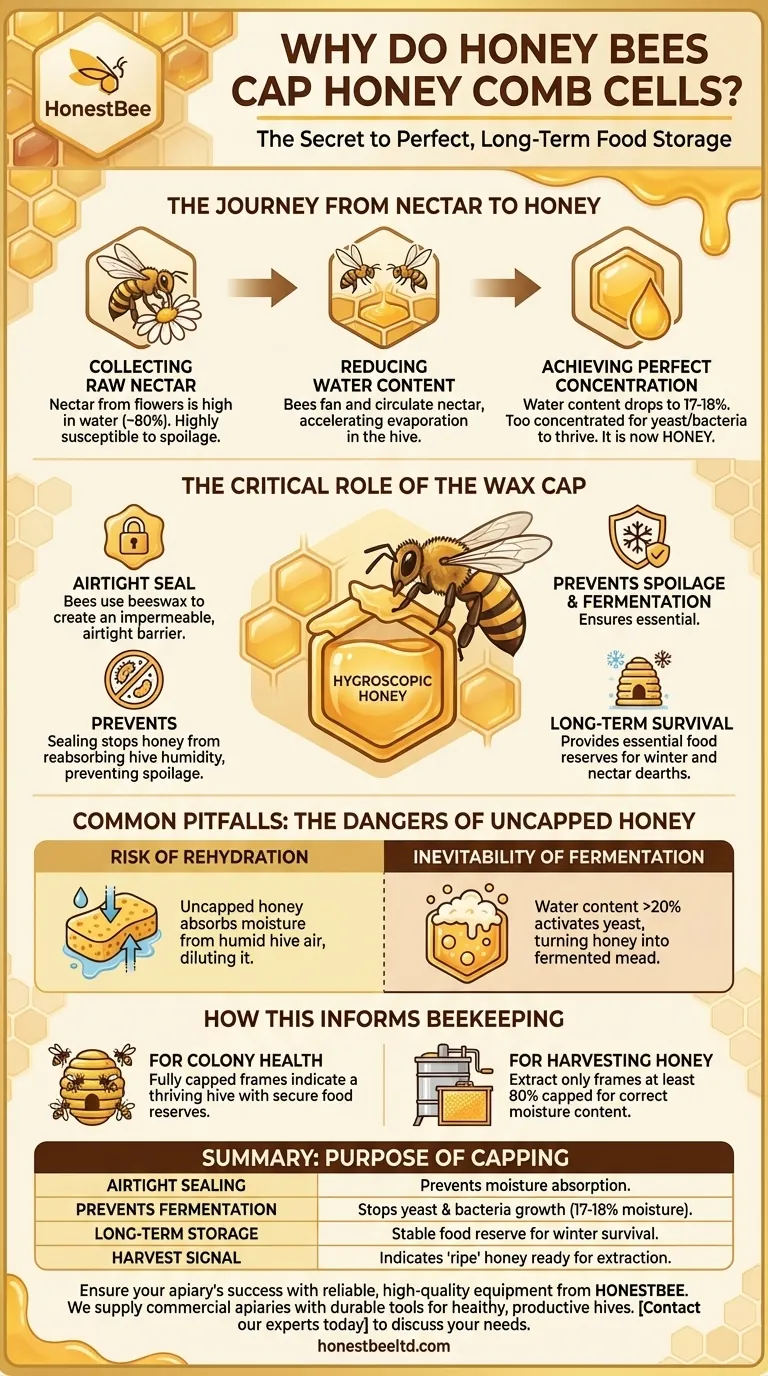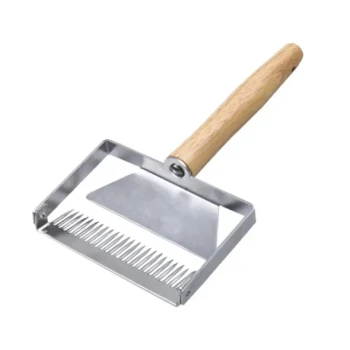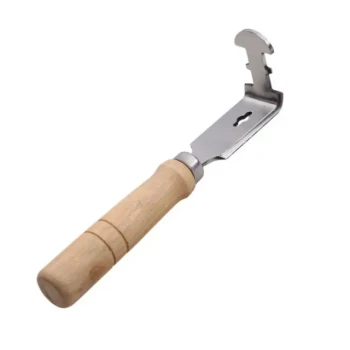Honey bees cap their honeycomb cells to create a perfect, long-term storage container for their food. The thin layer of beeswax they add acts as an airtight lid, sealing the dehydrated honey off from air and humidity. This seal is the final and most critical step in preventing the honey from spoiling, ensuring the colony has a stable food source to survive.
The wax cap is not just a lid; it's a signal. It tells the bees that the nectar has been sufficiently dehydrated to a moisture content of around 18%, a level at which fermentation-causing yeasts and bacteria cannot survive.

The Journey from Nectar to Honey
To understand the importance of the cap, we must first understand what it protects. The process begins with nectar, a sugary liquid that is high in water content and highly susceptible to spoilage.
Step 1: Collecting Raw Nectar
Foraging bees collect nectar from flowers, which can have a water content of 80% or more. This raw material is not yet honey and would quickly ferment if left in this state.
Step 2: Reducing the Water Content
Inside the hive, bees begin the dehydration process. They pass the nectar from bee to bee, exposing it to the warm, dry air of the hive. They also deposit it into honeycomb cells and fan it with their wings to accelerate evaporation.
Step 3: Achieving the Perfect Concentration
The bees continue this process until the nectar's water content drops to a stable level, typically between 17-18%. At this low moisture level, the sugars are so concentrated that microscopic yeast spores cannot thrive. The product is now officially honey.
The Critical Role of the Wax Cap
Once the honey is "ripe" or fully cured, it must be protected. Honey is hygroscopic, meaning it will readily absorb moisture from its surrounding environment.
Creating an Airtight Seal
Worker bees produce flakes of beeswax from glands on their abdomen. They chew this wax to make it pliable and then meticulously construct a cap over each cell filled with cured honey. This creates an impermeable, airtight barrier.
Preventing Spoilage and Fermentation
The wax cap is the hive's preservation strategy. By sealing the cell, it prevents the low-moisture honey from reabsorbing humidity from the air inside the hive. This guarantees the honey remains preserved and won't spoil or ferment.
Ensuring Long-Term Survival
This meticulously stored honey is the colony's food reserve. It provides the essential carbohydrates the bees need to survive through the winter and other periods when nectar is not available. Without properly capped honey, the hive would starve.
Common Pitfalls to Avoid: The Dangers of Uncapped Honey
Leaving cured honey uncapped would defeat the entire purpose of the dehydration process and pose a direct threat to the colony's food supply.
The Risk of Rehydration
The warm, bustling environment of a beehive is often humid. Uncapped honey would act like a sponge, immediately beginning to draw that moisture from the air and diluting itself.
The Inevitability of Fermentation
As the water content rises back above 20%, the dormant yeast spores present in all honey would activate. This begins the process of fermentation, turning the valuable food into a substance similar to mead, which is not suitable for the bees.
How This Informs Beekeeping
A beekeeper uses the bees' own signal to determine the right time for harvest. The presence of a wax cap is the most reliable indicator that the honey is ready.
- If your primary focus is the health of the bee colony: A frame of fully capped honey is a sign of a thriving hive with a secure food source for its future.
- If your primary focus is harvesting honey: You should only extract honey from frames where the cells are at least 80% capped to ensure it has the correct low moisture content for stable, long-term storage.
Ultimately, the simple wax cap is a testament to the honey bee's sophisticated and highly effective strategy for food preservation.
Summary Table:
| Purpose of Capping | Key Benefit |
|---|---|
| Airtight Sealing | Prevents honey from absorbing moisture from the humid hive environment. |
| Prevents Fermentation | Maintains honey's low moisture content (17-18%), stopping yeast and bacteria growth. |
| Long-Term Food Storage | Provides a stable carbohydrate reserve for the colony to survive winter and dearth periods. |
| Harvest Signal for Beekeepers | Indicates honey is 'ripe' and ready for extraction, ensuring quality and stability. |
Ensure your apiary's success with the right equipment. The meticulous process of honey capping underscores the need for reliable, high-quality beekeeping supplies. At HONESTBEE, we supply commercial apiaries and distributors with the durable tools and equipment needed to support healthy, productive hives. From hive components to harvesting tools, our wholesale-focused operations are designed to meet the demands of serious beekeepers.
Contact our experts today to discuss your supply needs and discover how we can help your operation thrive.
Visual Guide

Related Products
- Wide Adjustable Stainless Steel Honey Uncapping Fork with Scraper
- Stainless Steel Dual Blade Uncapping Plane
- Stainless Steel Double Sided Honey Uncapping Fork with Scraper
- Professional Wide Blade Honey Scraper for Beekeeping and Honey Processing
- Extra Wide Stainless Steel Honey Uncapping Fork with Scraper Beekeeping Tool
People Also Ask
- Why is post-harvest equipment maintenance important? Protect Your Apiary's Health & Investment
- How can you remove wax caps from frames when using an extractor? A Step-by-Step Guide
- Why is my honey frame not capped? Your Guide to Perfectly Ripe Honey
- What is honey uncapping? The Essential First Step to Harvest Your Honey
- How should honeycombs be prepared for honey extraction? A Step-by-Step Guide to a Clean Harvest



















